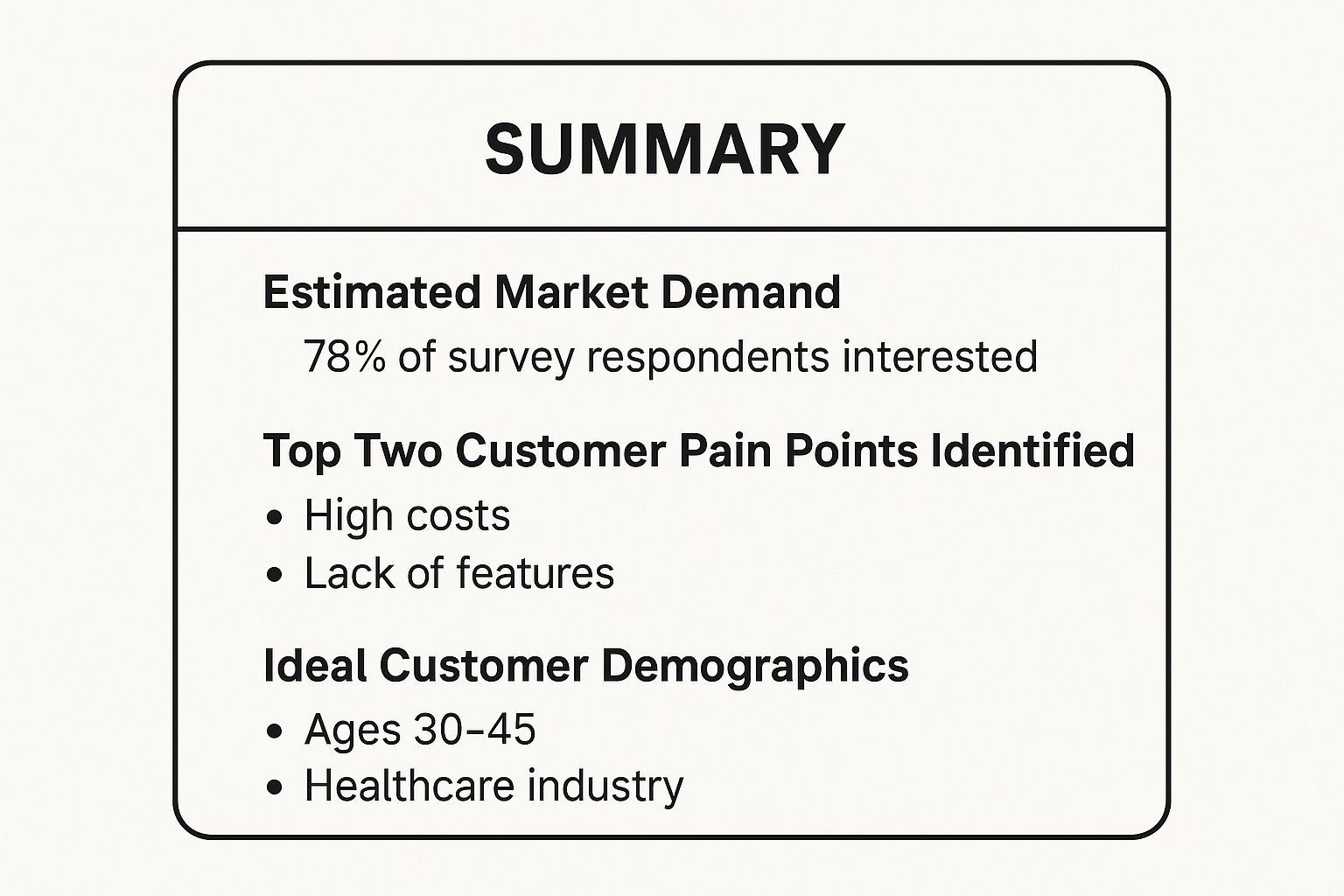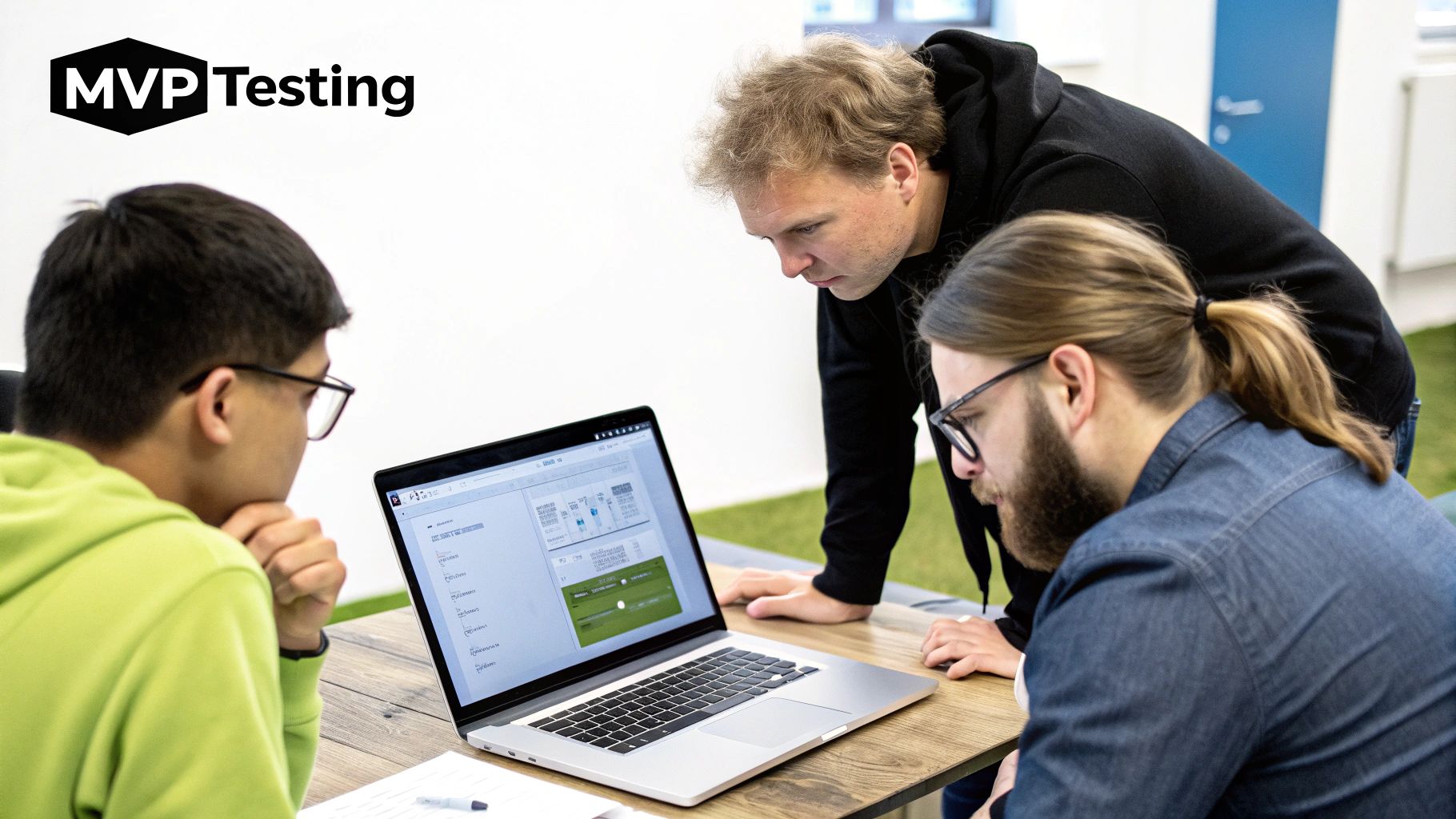We've all heard the horror stories. Pouring your heart, soul, and savings into a brilliant idea, only to launch to the sound of crickets. It’s a founder’s worst nightmare, but it doesn't have to be yours.
The old "build it and they will come" mantra is a fast track to failure. Today, being a smart entrepreneur means gathering cold, hard evidence, not just clinging to a great idea.
Why Most Startups Fail (And How You Can Avoid It)
Let’s be real for a second. The statistics are pretty brutal. A staggering 90% of startups don't make it.
When you dig into why, two massive reasons jump out: a lack of product-market fit (34%) and just plain bad marketing (22%). What this really tells us is that founders are skipping the most critical step of all—proving their idea actually has a place in the market before going all in.
This is where you can flip the script.
From "My Great Idea" to "Proven Demand"
Idea validation is your secret weapon. It’s the process of de-risking your entire venture by asking one simple, crucial question: Does my idea solve a real, painful problem for a specific group of people?
It's a mindset shift. You need to stop thinking like a builder and start thinking like a detective. Your job isn't to build a product; it's to uncover clues and data that confirm (or deny) your core assumptions.
This isn’t about fishing for compliments or getting people to tell you how brilliant your idea is. In fact, it's the opposite. You're actively inviting criticism and gut-wrenchingly honest feedback to find the fatal flaws before they can sink your business.
This image really breaks down the kind of data you're looking for.

The goal is to get specific. By zeroing in on a target audience and their biggest headaches, you can get tangible proof that people are actually looking for what you want to build.
The core of idea validation has nothing to do with your solution. It’s all about deeply understanding the customer's problem. Your first product isn't the app, the service, or the physical item—it's the evidence that people desperately want it.
Before we dive into the "how," here's a quick look at the methods we'll be covering. Think of this as your validation toolkit.
Key Validation Methods at a Glance
This table gives you a quick summary of the core validation techniques we'll explore in this guide. It's designed to help you understand the purpose of each method and when it's the right tool for the job.
| Validation Method | Primary Goal | Best For |
|---|---|---|
| Market Research | Understanding the competitive landscape and market size. | Early-stage analysis to see if the idea is viable. |
| Customer Interviews | Gaining deep, qualitative insights into customer pain points. | Uncovering problems and learning your customer's language. |
| Surveys | Collecting quantitative data from a larger audience. | Validating assumptions and spotting trends at scale. |
| Prototyping/MVP | Testing a core feature or solution with real users. | Getting tangible feedback on your proposed solution. |
| Landing Page Tests | Measuring actual purchase intent and interest. | Gauging demand before you've built anything. |
Each of these methods provides a different piece of the puzzle. Combining them gives you a much clearer, more complete picture of your idea's potential.
This guide will walk you through the practical, real-world steps to gather this evidence. For a deeper dive into the core principles, checking out other resources on effective idea validation is always a smart move.
Now, let's get to work turning your concept into a data-backed business ready for prime time.
Conducting Market Research That Actually Informs Your Idea
Before you ever think about writing a single line of code or sketching a logo, you need to put on your detective hat. I see too many founders skip this part, but trust me, it's foundational. Effective market research isn’t about getting lost in spreadsheets; it’s about painting a crystal-clear picture of the world your customers actually live in.

The real goal here is to get the lay of the land so you can find your unique, defensible spot within it. This starts with identifying your competitors, but don't just stop at the obvious players.
Direct vs. Indirect Competitors
Your direct competitors are the ones that jump to mind first—they offer a solution a lot like yours to the same group of people. Building a new project management app? Your directs are giants like Asana or Trello. Easy enough.
But the real magic happens when you start digging into the indirect competition.
- Indirect Competitors: These are the scrappy, alternative ways people are solving their problem right now. For that project management app, indirect competition could be a messy shared spreadsheet, a long Google Doc, or even a physical whiteboard covered in sticky notes.
You have to understand these workarounds. They reveal your true competition: ingrained habits. Your idea needs to be significantly better, not just slightly different, to pull someone away from what they're already doing. This deeper dive is what separates a good idea from a great business. If you want to get this right, you have to master how to conduct user research.
When you analyze these alternatives, you start to see their biggest flaws. And those flaws? That’s where your biggest opportunities are hiding.
Key Takeaway: Your most dangerous competitor isn't always another company. It's often the "good enough" solution your potential customers are already using. Your idea must offer a compelling reason for them to switch.
Uncovering Trends and Hidden Niches
Once you have a map of the competitive landscape, it’s time to look for the currents—what’s bubbling up? Tools like Google Trends are great for seeing what people are actively searching for, which can signal rising interest in a specific problem or solution. And yes, industry reports can give you the big-picture view of market size and growth.
But the real gold? It’s almost always buried in online communities.
Imagine a founder with an idea for a pet-sitting app. A quick glance at the market shows it's packed. It's a "red ocean," as they say. But what if they spent a few hours in Reddit forums and Facebook groups for pet owners? They might notice a recurring, frustrated conversation: finding reliable care for exotic pets like reptiles and birds.
Suddenly, a generic idea becomes a specific, validated opportunity. This is a niche that a surface-level analysis would have completely missed. It’s a focused, potentially profitable way to enter the market.
Don’t think of this research phase as optional—it’s the bedrock of everything that comes next. A 2023 report found that nearly 58% of failed startup founders wish they had done more research before launching. Learn from their mistakes.
Getting Honest Feedback From Your Target Audience
Market research gets you the map, but talking to actual people is how you find the treasure. Believe me, the single biggest threat to your business idea is your own set of assumptions. The only way to bust through them is to get direct, honest, and sometimes brutally frank feedback from your potential customers. This is where the story behind the numbers comes to life.

Seriously, this part of the process is non-negotiable. It’s the moment you stop guessing and start knowing. Your goal isn't to fish for compliments or hear people say they love your idea; it's to uncover the raw truth about the problems they're facing every day.
Crafting Questions That Uncover Truth
The quality of the feedback you get is a direct reflection of the quality of the questions you ask. Whatever you do, avoid leading the witness. Asking something like, "Wouldn't this new feature make your life easier?" is a dead end. You'll get much richer information by asking open-ended questions.
Here’s a simple way to reframe your approach:
-
Instead of: "Do you think our app is a good idea?"
-
Try asking: "Tell me about the last time you struggled with [the problem your app solves]."
-
Instead of: "Would you use a service that did X?"
-
Try asking: "What are you currently doing to manage [the problem]? What do you like or dislike about that method?"
Questions like these get people talking. When they start telling stories, you'll hear the emotion, frustration, and weird workarounds they’ve cobbled together—things you never would have guessed on your own. These are the golden nuggets that will shape a product people actually want to use.
Pro Tip: Don't sell your solution during these interviews. Your only job is to listen and learn. The second you start defending your idea is the second you stop getting honest intel.
Blending Interviews with Surveys
Customer interviews are amazing for getting the "why" behind someone's behavior—the deep, qualitative stuff. The only problem is, they’re tough to scale. To get the bigger picture, you need to mix these intimate conversations with well-designed surveys.
Surveys deliver the "how many." They give you the hard, quantitative data you need to back up the patterns you're seeing in your one-on-one chats. So, if three interviewees bring up the same specific pain point, a survey can tell you if a whopping 60% of your entire target market shares that same frustration.
- Interviews help you uncover nuanced problems and hear the exact words customers use to describe them.
- Surveys help you quantify how widespread those problems really are and start segmenting your audience.
This blended approach gives you a solid, realistic customer profile—one that’s grounded in reality, not just your own assumptions. It's a crucial part of the journey to finding that sweet spot, which you can see in these real-world product-market fit examples.
Finally, once you have a prototype or MVP ready, you can take your feedback game to the next level. Using some essential usability testing methods allows you to see what people do, not just what they say. This is where you can get incredibly actionable feedback on your product's flow and user experience by observing real interactions.
You’ve confirmed the problem is real. Now it’s time to see if your solution actually holds water.
This is the point where a lot of founders get tripped up. They think they need a perfect, polished, feature-packed product just to get started. The truth? Not even close. What you really need is a Minimum Viable Product (MVP), and it's not some half-baked app—it’s a powerful tool for learning.
An MVP is built to answer one, and only one, question: does your core solution actually deliver value to real people? It’s the simplest, most stripped-down version of your product you can possibly build to start seeing how people behave in the wild. This isn't just a step; it's a fundamental mindset that lets you validate your idea without risking a ton of time and money.
What Does an MVP Actually Look Like?
Forget the idea that an MVP has to be a piece of software. It can be anything, really. The only rule is that it has to be the simplest thing you can create to test a core assumption about your business and measure what people actually do.
Here are a few ways to get a real-world signal without a huge upfront effort:
- The Landing Page MVP: This is your fastest path to a "yes" or "no." Just spin up a single webpage that nails your value proposition. Add a clear call-to-action, like a waitlist sign-up or an early-bird offer. Your conversion rate here is a direct pulse on market interest.
- The Concierge MVP: With this one, you become the product. You deliver the service manually to your very first customers. Thinking of an automated meal-planning service? Great. You’ll start by personally creating custom meal plans for your first few clients. It’s not scalable, but you’ll prove people will pay for the result long before you write a single line of automation code.
- The 'Wizard of Oz' MVP: This is a classic. It looks like a fully functional, automated product to the user, but behind the curtain, you’re pulling all the levers manually. They think they’re using a slick system, but it’s just you. This lets you test the entire user experience and demand without a massive engineering bill.
Imagine you have an idea for a custom t-shirt design app. You could start with nothing more than an Instagram page showcasing some cool mockups. Take orders through DMs, and then walk down the street to coordinate with a local printer. That simple setup validates demand, pricing, and which designs actually sell—all before you’ve even thought about code.
An MVP isn't about building the minimum. It’s about running the smallest possible experiment to learn if your core idea is right. Your question shouldn't be, "What's the least I can build?" It should be, "What's the fastest way I can learn?"
From Idea to Actionable Data
Going through the process of building an MVP forces you to get brutally honest about what matters. You have to distill your grand vision down to its absolute essence: the one thing your product must do to solve the customer’s problem. Focus all your energy there. If you want to see how other successful companies started small, check out these diverse minimum viable product examples.
This approach gives you something far more valuable than survey responses. You get to see what people do when presented with your solution. Are they signing up? Are they pulling out their credit cards?
That kind of tangible behavior is the strongest validation you can possibly get. It's the proof you need to confidently invest more time, money, and energy into your business.
Will They Actually Pay for It? Testing Your Business Model and Pricing
A brilliant solution that doesn’t make money is just an interesting side project. You've done the hard work to confirm people have the problem and your solution clicks with them. Now it's time to answer the ultimate question: will they actually pull out their wallets?

This is the moment we move past friendly feedback and into the real world of commitment. You have to create scenarios where potential customers make a choice that involves their money, even if it's a small amount at first. This is how your idea goes from just "desirable" to financially viable.
Putting a Price Tag on Your Solution
Here's a hard truth I've learned: asking people, "How much would you pay for this?" rarely works. It’s a hypothetical question, and you'll get hypothetical, unreliable answers. People are notoriously bad at predicting their own spending.
A much better approach is to test real pricing models directly. Get them to vote with their actions, not their words.
Here are a few ways I’ve seen this work wonders:
- Run a Pre-Sale: This is my personal favorite. Offer your product or service at a discount before it’s even fully built. If people are willing to pay now for a solution they'll get later, you have an incredibly strong signal of real demand. It's the ultimate validation.
- Present Tiered Options: On your MVP's sign-up page or even just a landing page, create two or three pricing tiers. Don't worry if the product isn't ready. Just track which option gets the most clicks. This tells you what features people are drawn to and what price point feels right to them.
- A/B Test Your Model: Are you stuck between a subscription model and a one-time fee? Don't just guess. Set up two different landing pages, drive traffic to both, and see which one converts better. Real data will end the debate for you.
Key Insight: The goal here isn't just to make a quick buck. It's to gather cold, hard evidence. Every click, sign-up, or pre-order is a data point proving your business model has a pulse.
Getting a Grip on Your Unit Economics
Okay, so you've tested a price and people are biting. Great. But can you actually build a profitable business around that price? This is where you need to get familiar with some simple but critical metrics that every single founder needs to know.
We’re talking about your unit economics. The two most important numbers are:
- Customer Acquisition Cost (CAC): How much does it cost you in sales and marketing to get one new customer through the door? For a deeper dive, check out our guide on startup marketing strategies.
- Lifetime Value (LTV): What’s the total amount of money you can realistically expect to make from a single customer over their entire relationship with your business?
The golden rule for a sustainable business is simple: your LTV must be significantly higher than your CAC.
Running these numbers early, even as rough estimates, forces you to get real about your marketing channels, your pricing, and your long-term plan. This financial gut-check is where so many startups fall apart.
In fact, the data shows that only about 40% of startups ever become profitable, with the rest just breaking even or losing money. Don’t let that be you. Validating your business model and pricing isn’t just a "nice to have"—it's an absolute must for survival.
Got Questions About Validating Your Idea? We’ve Got Answers
Even with a solid plan, stepping into the validation process can feel a bit like walking into the unknown. It’s totally normal for questions and a few "what ifs" to pop up as you start digging in.
Let's tackle some of the most common hurdles I see entrepreneurs face when they're trying to figure out if their big idea has legs.
How Much Is This Going to Cost Me?
This is probably the number one question I get, and the answer usually surprises people: it can cost you next to nothing. Seriously. Early-stage validation is all about scrappy, creative thinking, not big budgets.
You can start talking to potential customers for free. Just tap into your existing network—think old colleagues, friends, or even people you connect with on LinkedIn. For gathering hard numbers, tools like Google Forms are completely free and perfect for sending out quick surveys.
Thinking about a landing page to gauge interest? You can get a domain and a year of basic hosting for less than $100.
The real secret is to start small. Focus on these low-cost, low-effort tests first. Your goal is to get a feel for the market and see if your core beliefs hold up before you even think about pricey ad campaigns or hiring a dev team for a fancy prototype.
How Do I Know for Sure That My Idea Is Validated?
Okay, so there's no giant flashing sign that says "VALIDATED!" This isn't a single finish line you cross; it's more like gathering clues that build a convincing case. But there are definitely strong signals that tell you it's time to move forward with confidence.
You’re looking for a perfect storm of positive signs:
- You've Hit a Nerve: A huge chunk of the people you interview don't just agree with the problem you're solving—they feel it. It's a real, top-of-mind pain point for them.
- People Are Willing to Commit: This is the ultimate proof. Are people actually willing to pull out their wallets for your MVP, even if it's super basic? Pre-orders and early sign-ups are pure gold here.
- Your Landing Page Is Working: Seeing a conversion rate of 10-15% or higher from your target audience is a fantastic, tangible sign of interest.
- They're Actually Using It: When people test your prototype, they aren't just clicking around aimlessly. They're actively trying to get value out of it and accomplish the main goal you promised.
You’ve got enough validation when you have real, hard evidence that a specific group of people wants your solution and is ready to pay for it.
You don't need 100% certainty—that's a myth. What you need is enough conviction, backed by data, to justify putting more time and money into this. This evidence is a massive piece of the puzzle for defining overall project success factors.
What if I’m Wrong? What if the Idea Is a Dud?
First off, take a breath. This is a win, not a loss. I mean it.
The whole point of this process is to find those deal-breaking flaws before you’ve sunk a year of your life and your savings into a black hole. Discovering your idea is off the mark means the system is working perfectly.
When this happens, you’ve got two smart moves:
- Pivot. The feedback you got didn't just tell you "no." It gave you clues. Hidden in those conversations is likely a different, more urgent problem your audience is facing. Tweak your concept to solve that newly discovered pain point.
- Move On. Sometimes, the market just isn't there, or the problem isn’t as painful as you thought. Knowing when to walk away is a superpower. It’s far better to shelve a weak idea and jump to the next one, armed with all the experience you just gained.
Can I Do This Without Knowing How to Code?
Absolutely. You do not need to be a developer to validate a business idea. In fact, some of the best validation methods are completely tech-free.
You can use design tools to create surprisingly realistic, clickable prototypes that show people how your product would work. This is perfect for getting feedback on the user experience without writing a single line of code.
Even better, you can try a "concierge" MVP. This is where you manually deliver the service to your first few customers. It’s an incredible way to prove that people want the outcome your idea provides before you ever spend a dime trying to automate it. The focus is always on testing the value, not the tech.
Validating your business idea is the first, most crucial step toward building something real. If you're looking for the creative talent to bring that validated idea to life, Creativize is here to help. Our platform connects you with skilled branding designers, animators, and other creative professionals who can turn your vision into reality. Find the right creative partner for your project at Creativize.

